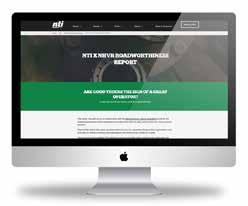key centres of demand, supply and the processing of high-value and containerised freight. However, too often they act as bottlenecks on our supply chains, limiting access to key markets for exporters and increasing costs for consumers. Congestion on key routes, and land-use planning that does not consider freight and regulatory constraints on our gateways, are common challenges. The audit went on to say that local agricultural infrastructure is often poorly maintained and lacks capacity. Infrastructure constraints are coupled with inefficient regulation in our regions, where freight operators have to deal with a range of different access arrangements. The report concluded that Australia is well positioned to take advantage of Asia’s economic development. But to do so, we need to ensure our freight and supply chains operate efficiently and minimise costs for business and consumers. That report was pre-Covid19. Since then, the importance of freight productivity has become even more evident. Input costs for the freight sector are rising. In Australia, average wages and fuel costs have both outstripped the growth in the Consumer Price Index (CPI) over the past 20 years. Labour and fuel account for the majority of marginal road transport costs, per kilometre travelled. Vehicle registration costs will keep rising. With the scales tipping the balance on input costs business owners must continue to innovate and get the most out of their investment if there is to be revenue left at the end of the day.
It seems fairly obvious that supply chain infrastructure that enables more streamlined and effective delivery of goods and services is efficient and therefore productive and therefore competitive. The winners are transport businesses, their customers, the consumer and the economy as a whole. The big question is – to what extent is regulation and infrastructure in WA holding this equation back and is it holding the state and national economies back? In WA, we have some well-known and frustrating examples of connectivity barriers and until we overcome them, we’ll continue to be less than efficient. In practical terms, we need our transport regulators to confront these obstacles rather than accept them as being fatal to better access. The recent decision to improve network connectivity to Tonkin Highway from Bedfordale Hill was a major step forward and Main Roads should be congratulated for the decision. We can’t stop there however as there are other blockages into the city that need to be overcome – Greenmount Hill, Welshpool Road and Muchea are all sore points with industry. High profile strategies such as the Revitalising Agricultural Freight Plan, whilst identifying some positive projects, have tended to skirt around some of these key issues. Perhaps a special Road Freight Connectivity Task Force should be formed, which has very practical terms of reference and good representation from small to medium sized transporters, to develop a strategic plan to address these issues
through infrastructure improvements, because increased access can’t only be based on more and more conditions on the transporters when the industry is continuing to invest in state of the art equipment and gaining no advantage from it. The task force could also review the RAV network in light of innovations in current equipment to ensure it is fit for purpose. For good measure the same group could also look at protecting freight corridors for the future. Although we assume this is fundamental to our planning processes, we see examples every day of the tension between freight and the general community which unfortunately contributes to a negative view of the industry. Whilst on the topic of industry reputation, I can’t let this opportunity go by without mentioning driver facilities. Industry groups such as the LRTAWA, Western Roads Federation and the TWU are working very hard to get funding for better facilities built. Those groups are also advocating with various stakeholders for access to their site facilities for truck drivers. Time and time again we are told that access is restricted because the drivers don’t respect the facilities. We know this is a minority of people but the whole industry is tarnished by their lack of care and behaviour that gives pigs a bad name. If readers of this magazine have any ideas about how we can address this problem your industry association would like to know as it stands between you as a driver and decent facilities.
Plans to modernise traffic infringement processes Systems Network to future-proof smart operation of the road network. Smart Freeway technology is also being delivered as part of the Mitchell Freeway Southbound Upgrade: Hodges to Hepburn project, with nine entry ramps from Hester Avenue to Warwick Road to receive coordinated ramp signals. The $140 million Smart Freeway Mitchell Southbound program is jointly funded on a 50:50 basis by the Australian and Western Australian governments.
T
The McGowan Government is taking the next step to modernise the way traffic infringements are managed across the State. The new infringement processing system will provide people with more options to manage and pay their traffic infringements. Importantly, for someone experiencing financial difficulty, the new system will give greater flexibility including allowing for the first time, part payment arrangements or payment extension options. $13.7 million has been allocated in this
year's budget for these important reforms. Legislation is being drafted to support the new system's improved features. The new system will also allow people to manage infringements online, including nominating the driver and viewing the evidence. Businesses are being asked to provide information about contemporary solutions to inform the new system's design, through a Request for Information managed by the Road Safety Commission. The new system is expected to be operational in 2023. WATM • May 2021
19














